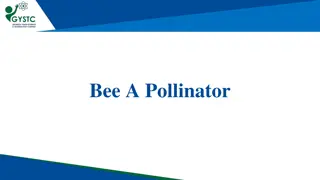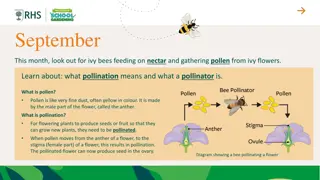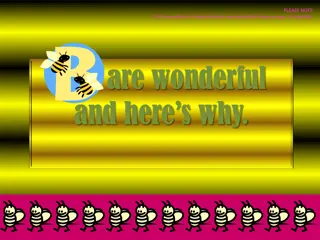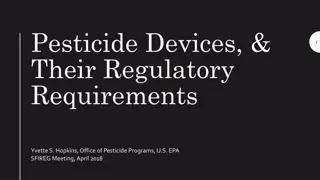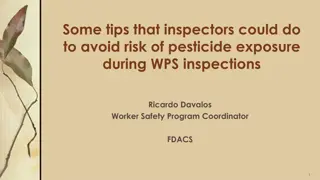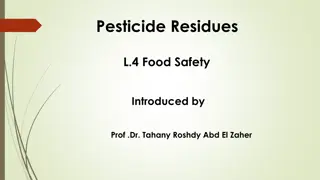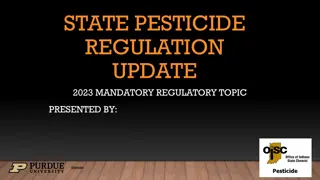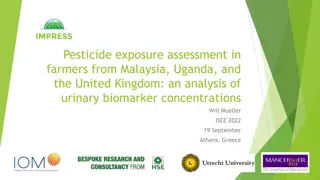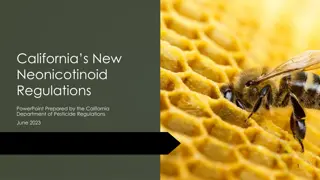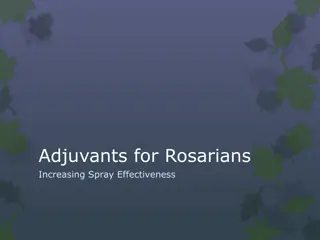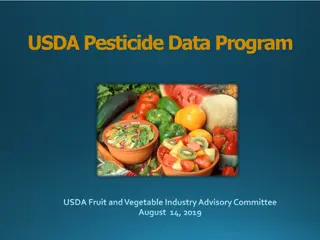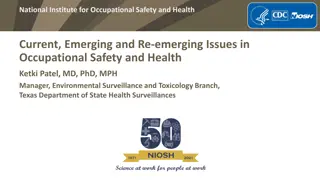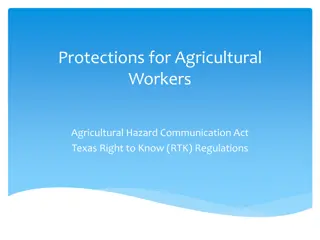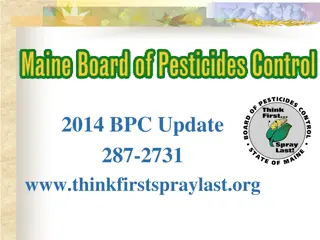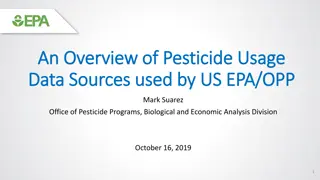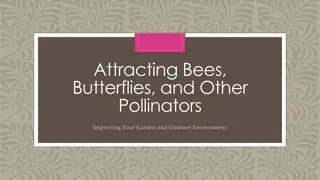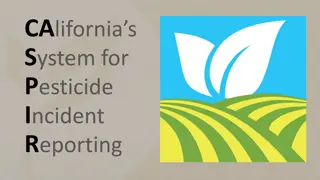Understanding Pesticide Use and Impact on Pollinators
Pesticides play a crucial role in agricultural production in areas like New Hampshire and Maine. However, their use raises concerns about potential hazards, especially for pollinators like bees. Different types of formulations and tank mixes carry varying risks to these essential insects. It is important to consider the latest research findings to balance the need for pesticides with their impact on pollinator populations.
Download Presentation

Please find below an Image/Link to download the presentation.
The content on the website is provided AS IS for your information and personal use only. It may not be sold, licensed, or shared on other websites without obtaining consent from the author. Download presentation by click this link. If you encounter any issues during the download, it is possible that the publisher has removed the file from their server.
E N D
Presentation Transcript
Pesticides Gary Fish Maine Board of Pesticides Control 28 SHS Augusta, ME 04333-0028 207-287-7545 gary.fish@maine.gov
My premise I am not here to defend or indict pesticides I will try to outline the latest research findings I am not a bee or CCD expert by any means My head continues to spin from all the reading I have done
Pesticide Use in NH NH agricultural production (organic and conventional) relies on many pesticide families for yield and quality Potatoes Apples Vegetables Small Fruits Nurseries Sod Farms Turf and Ornamental managers rely on them, and Homeowners rely on them too 2011 NH Insecticide use by licensed private and commercial applicators Insecticide Class Total Pounds Organophosphates 6259 Nitro Neonics 4315 Pyrethroids 4047 Other 3573 Carbamates 2314 Petroleum Oils 1840 Cyano Neonics 90 Total 22,438
Home & Garden (Homeowner) Use of Pesticides in Maine 8% of Conventional Pesticide Use, but 15% of the Insecticide Use National Data Qualitative Estimate of Insecticides Sold * 67% herbicides 22% insecticides 11% fungicides Active Ingredient Number of Units Sold Bifenthrin Cypermethrin Carbaryl Chlorantraniliprole Imidacloprid Pyrethrins 18,000 12,000 10,000 7,500 2,500 2,100 * 2013 Maine Sales Reports
Formulation Toxicity Top 27 most toxic insecticide formulations to honey bee adults Tested at row crop application rates with a tower sprayer J. Econ. Entomol. 1 8 (2015); DOI: 10.1093/jee/tov269
Formulation types differ in risk to pollinators More risky Dusts Microencapsulated Wettable powders Flowables Emulsifiable concentrates Systemic products Some adjuvants Super-Organosilicone surfactants No endorsement intended or implied
Different tank mixes may also increase risk to pollinators Some combinations can be very risky Insecticides mixed with miticides Insecticides mixed with fungicides or PBO Acetamiprid (Assail) and propiconazole (Orbit) Pyrethroids and propiconazole Piperonyl butoxide and some neonicotinoids Avoid tank mixes entirely No endorsement intended or implied
Even pesticides approved for organic grower use can be highly toxic to pollinators Toxicity of Common Organic-Approved Pesticides to Pollinators Soaps and Oils, only when directly sprayed upon the pollinator Eric Mader The Xerces Society for Invertebrate Conservation
Recent research on botanical pesticides Acute Toxicity and Sublethal Effects to Honey Bees Andiroba oil, Garlic extract, Eucalyptus oil, Rotenone, Neem oil and Citronella oil applied to adults and fed to larvae All but Andiroba oil caused significant mortality to adult bees Andiroba, Garlic and Neem caused significant larval mortality These may work like insect growth regulators preventing ecdysis (moulting) J. Insect Sci. (2015) 15(1): 137; DOI: 10.1093/jisesa/iev110
Neonicotinoids - History Neonicotinoids are insecticides and of course they can and will kill bees, other pollinators, beneficials and aquatic invertebrates Came onto the market when EPA began to encourage registration of alternatives to organophosphates and carbamates Imidacloprid came first in 1994 and was originally conditionally registered for ornamental & turf uses The rest soon followed after EPA instituted a Reduced Risk (RR) and OP Alternative (OPA) accelerated registration process Thiamethoxam 2000 Acetamiprid 2002 Clothianidin 2003 Dinotefuran 2004 Thiacloprid was conditionally registered in 2003 outside of the RR/OPA program
More history Neonicotinoids were favored for their low mammalian toxicity lack of mammalian CNS effects, and lack of carcinogenic (cancer) effects Use rates are very low (ml vs pts/Ac) EPA knew all along that they had some negatives: Very water soluble (good & bad) very leachable (groundwater concerns) fairly persistent in woody plants and soils
Neonic history EPA decided right from the beginning to manage the negatives with very specific label language Ground water warnings, reduced rates, pollinator warnings, etc. EPA scientists agreed that using neonics as labeled would be a better alternative to the continued use of OPs and carbamates because: Ops and Carbamates are much higher in mammalian toxicity, data on carcinogenicity is equivocal and nervous system effects are definite
Recent neonic studies Assessment of Chronic Sublethal Effects of Imidacloprid on Honey Bee Colony Health Sub-lethal effects of imidacloprid No significant effects on foraging up to 100 ug/kg Varroa mites significantly higher in exposed colonies High doses in pollen could reduce colony health and reduce overwintering success Relevant field dose from seed treated crops had negligible effects March 18, 2015 DOI: 10.1371/journal.pone.0118748
Recent neonic studies Neonicotinoid pesticides severely affected honey bee queens Thiamethoxam and Clothianidin fed in pollen supplements at environmentally relevant concentrations Queens s ovaries and stored sperm affected Flight behavior was not affected Scientific Reports 5, Article number: 14621 (2015) doi:10.1038/srep14621
Recent neonic studies Neonic seed treatments negatively affected wild bees Clothianidin and beta-cyfluthrin treated canola seed in Swedish fields caused: Reduced density of wild (bumble and solitary bees) Reduced nesting in Osmia (solitary bee) Reduced colony growth and reproduction in Bumblebee No significant effects on Honey bee colony strength Nature 521, 77 80 (07 May 2015) doi:10.1038/nature14420
Recent neonic studies Bees prefer sucrose solutions with neonicotinoids No feeding avoidance in honey bees and bumblebees Both preferred solutions with imidacloprid and thiamethoxam Those two neonics and clothianidin reduced feeding for both species Why are they attracted to something that reduces their overall feeding?
Future of neonicitinoids EPA is opening the re-registration docket on all the neonicotinoids EPA - some uncertainties have been identified since their initial registration Environmental fate and Effects on pollinators Concerns about persistence and bioaccumulation Higher levels in guttation water Higher levels expressed in soil injected woody plants Higher levels expressed in ornamental plants
What if neonicotinoids are banned Other pesticides will fill the vacuum Pyrethroids, OPs, Carbamates, Spinosad, Phorate, Chlorantraniliprole, Indoxacarb, Spinetoram, etc. Most of these are as toxic or more toxic to bees than neonics Some of these are also systemics What if bee declines continue? We need to look at the whole universe of exposures insecticides, fungicides, herbicides surfactants and other adjuvants tank mixes and synergistic effects
The facts about systemic insecticides Richard Cowles - CAES CCD has not diminished in countries where neonicotinoid insecticide use was curtailed6, CCD is not found in Australia, where neonicotinoid insecticides are used, but where Varroa mite (a parasite and vector of bee viruses) is also not found6, 96% of colonies with CCD have been found to harbor a complex of viruses, for which Israeli Acute Paralysis Virus is most strongly implicated7; 6 Ratnieks, FLW and N. L. Carreck. 2010. Science 327: 152 - 153. 7 Cox-Foster, D. L., et al. 2007. Science 318: 283 - 287.
Do some pesticides make bees more susceptible to disease? One study shows how the miticides* beekeepers use are the most risky for making the bees susceptible to Nosema ceranae Relative risk of nosema was significantly worse for: Chlorothalonil (2.31) Pyraclostrobin (2.85) *DMPF (Amitraz) (2.13) Bifenthrin (2.08) Endosulfan (1.60) *Fluvalinate (2.43) PLoS ONE 8(7): e70182. doi: 10.1371/journal.pone.0070182
Do some pesticides make bees less susceptible to disease? One study shows how the some pesticides actually reduce the incidence of nosema compared to the control, including all the neonics that were found Relative risk of nosema was significantly less for: Captan (0.59) Cyprodinil (0.31) Difenoconazole (0.31) Acetamiprid (0.31) Carbaryl (0.42) *Coumaphos (0.62) PLoS ONE 8(7): e70182. doi: 10.1371/journal.pone.0070182 Diazinon (0.56) Esfenvalerate (0.51) Imidicloprid (0.31) Indoxacarb ( 0.28) Phosmet (0.36) Thiacloprid (0.35)
What about herbicides Much more research needed to access the impacts that herbicides have on pollinator floral resources Herbicides have been used for years Growers have always strived for clean fields and headlands Are the impacts related to the way herbicides are used or are impacts more related to the intensity of the agriculture? These questions need to be answered
What has EPA done? EPA and the State FIFRA Issues Research and Evaluation Group (SFIREG) have been discussing better ways to label pesticides for pollinator protection since I started as a regulator in 1988 Pesticide labels have always had warnings and restrictions Neonics and new systemic insecticides have new labeling to help protect pollinators
Look for the bee icon on new labels Products with acute or residual toxicity to pollinators will have the bee icon on their labels The new warnings will be next to that icon
Maine DACF Pollinator protection plan The Maine DACF developed a pollinator plan It is based on the North Dakota plan It stresses voluntary measures such as education, BMPs and communication It does not contain any new regulatory requirements http://www.maine.gov/dacf/php/pesticides/documents2/pollinators/Maine%20DACF%20Pollinator%20Protection%20Plan%206-2015.pdf
Plan contents Challenges Faced by Beekeepers Challenges Faced by Growers and Pesticide Users DACF Activities Committed to Pollinator Health Best Management Practices Beekeeper Best Management Practices Landowner/Grower/Agency Best Management Practices Pesticide User Best Management Practices Supporting Pollinator Forage and Habitat
Summary Insecticides do kill bees Both growers and bee keepers need to follow BMPs and practice IPM to reduce the overall impacts of pesticides on bees Fungicides need to be carefully evaluated for effects on immature bees Overall grower practices (including herbicide use) need to be evaluated for reductions in floral resources Scientists, growers and bee keepers need to work together to help figure out the risks and benefits of pesticide use
Questions? That s all folks!



